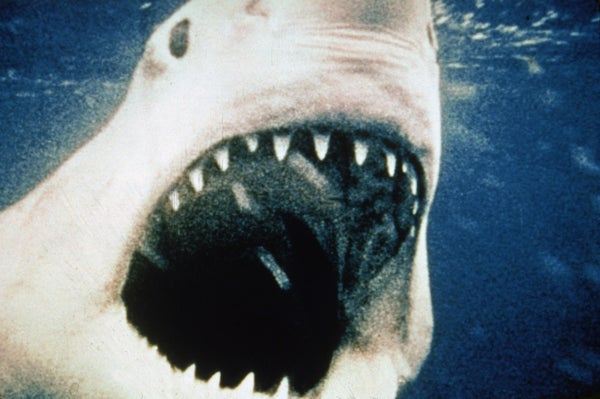The Applause for Jaws despite Flaws
Fifty years ago the movie Jaws scared beachgoers and demonized sharks. Now, however, the public and our beaches are evolving a better understanding

Universal Pictures/Courtesy of Getty Images
The motion picture Jaws deserves another round of applause on its 50th birthday despite its flaws. Released on June 20, 1975, this classic invented the summer blockbuster genre, made sharks a familiar (if demonized) foe and gave a visceral picture to the words “shark attack.”
But today humanity has grown to have a better appreciation for all sharks, even those that swim near the beach. We owe some of the public sentiment that it’s “safe to go back in the water” to Jaws.
Initially, the movie’s biggest effect came from its portrayal of shark bites as intentional “attacks” on swimmers. The fictional story of a human-shark relationship (and human-ocean relationship) in which humans are on the menu has been one of the most successful Hollywood narratives in motion picture history. More movies, including sequels and spin-offs, have created a lasting narrative and industry of “rogue” sharks, rabid dogs, territorial bears, hungry crocodiles, and other animals that intentionally and sometimes hysterically attack innocent people in classic Sharknado style.
On supporting science journalism
If you’re enjoying this article, consider supporting our award-winning journalism by subscribing. By purchasing a subscription you are helping to ensure the future of impactful stories about the discoveries and ideas shaping our world today.
The public believed this story of intentionality so completely that it came to see every shark bite as essentially a murder, and every shark as a potential murderer, with the beach as the scene of a crime committed by a deviant monster against innocent beachgoers. Importantly, the rogue narrative of sharks gaining a taste for human flesh predated Jaws and was largely invented by Australian surgeon Victor Coppleson in the 1950s. Peter Benchley’s original 1974 novel Jaws and the blockbuster movie that adapted it provided the justification for, and weakened pushback against, all the antishark public policies that followed, including revenge shark hunts, shark derbies, changes to fishery laws that classified sharks as waste fish, delays in enacting shark conservation and the placement of lethal shark nets on some of the world’s beaches.
Another piece of the Jaws story was its portrayal of an innocent coastal community being preyed upon. Here, beachgoers were not cast as large land animals entering into the foreign domain of a dynamic marine ecosystem but as property owners and recreational water users who had the right to expect nature to behave in a domesticated manner. This misconception that the beach is safe introduced as big a falsehood to the public as the idea that all sharks are dangerous. The ocean is constantly in flux. The direct opposite of a “shark bites are intentional attacks” narrative would be a truer but much less Oscar-worthy story about the beach as a wild, dynamic and active ocean environment.
In a 2014 paper in the Australian Journal of Political Science, I argued that politicians use familiar fictional films and movies as the basis for explaining real-life events—and proposed the term “Jaws effect” to describe the phenomenon. As I wrote, the Jaws effect can be seen as a political instrument that uses films to reinforce three themes: “that sharks are intentionally hunting people, that shark bites are fatal events and that killing individual sharks will solve the problem.”
Following a terrible fatal shark bite in Western Australia in 2000 and subsequent shark bites and encounters, Western Australia’s then premier Colin Barnett repeatedly used the term “rogue sharks.” Barnett asserted such sharks were returning to the beach to attack swimmers and that there needed to be a law to help the government kill specific target sharks that were intent on haunting the local beach community.
During this period, in the Guardian, Benchley wrote an open letter to the Australian public about the 2000 shark-bite case and the political directive to hunt down the shark responsible. He wrote, “This was not a rogue shark, tantalized by the taste of human flesh and bound now to kill and kill again. Such creatures do not exist, despite what you might have derived from Jaws.”
The Jaws effect, however, continues in Australia today. In 2024 the District Council of Elliston passed a motion to allow fisheries officers in South Australia to kill great white sharks following shark bites in that area. The motion stated, “Sharks are capable of learned behavior. The purpose of terminating the shark responsible for an attack is to prevent that shark from using that behavior to harm another person.”
Yet, at 50 years old, Jaws is also a celebration of sharks, and the film created a fascination that helped lead to more than two generations of new shark researchers. Indeed, some of the people who have done the most for shark conservation worked on Jaws. Cinematographer Valerie Taylor helped collect footage of sharks that was used in the movie. And in Australia’s state of New South Wales, Taylor was also one of the leaders in the creation of conservation laws to protect the gray nurse shark, which became the first protected species of shark in 1984. Additionally, the late Leonard Compagno, who was a scientist and consultant on Jaws, led an effort to protect white sharks in South Africa. The idea that Jaws led to bad public relations is too simple a story. Our reading of the movie and understanding real-life sharks, the public and our beaches are evolving. Jaws is better at 50, sharks are seen more positively in 2025, and the public is more engaged in shark conservation and beach safety. Earlier this year in Australia, I presented the first yearly Jawsie Awards. The awards include one given to the most outlandish reports of shark attacks and are intended spur real beach safety awareness .
I would be remiss if I did not note the connection between Jaws, the false rogue shark theory and current debate over orcas ramming into yachts off the Strait of Gibraltar. Both National Geographic and the BBC, for example, have run headlines about such “rogue” orcas. In the mix of stories to explain this behavior, a few claimed that it was an “orca scorned”–type of situation in which a female orca had been traumatized by a boat previously and was now training her young to attack boats in revenge. That’s very Jaws, or perhaps Jaws 3, but there will be no awards for this “fish story.”
This is an opinion and analysis article, and the views expressed by the author or authors are not necessarily those of Scientific American.
Source link




